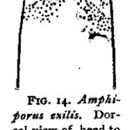en
names in breadcrumbs


(from Coe, W. R. (1901). Papers from the Harriman Alaska Expedition. XX. The nemerteans.. Proc. Wash. Acad. Sci.. 1-110.)
The color of the individuals of this species is commonly a homogeneous, opaque white, very pale flesh color, or pale yellowish-white. This color is continuous throughout the length of the body, both above and below, except where the internal organs show through. The smaller specimens are pale, while the larger ones almost always exhibit a brownish color, which indicates the position of the intestine. Sometimes minute reddish-brown specks are distributed over the dorsal surface. Occasionally a worm of this species is met with in which the intestinal lobes are pale organ. The brain is plainly distinguishable in the living worm because of its pinkish coloration.
(from Coe, W. R. (1901). Papers from the Harriman Alaska Expedition. XX. The nemerteans.. Proc. Wash. Acad. Sci.. 1-110.)
Body extremely elongated for the genus, rounded throughout; not capable of the great contraction which characterizes many species of the genus; only moderately flattened; posterior extremity slender. Head usually narrower than esophageal region. The general shape of the body resembles that of Emplectonema. In shape of body, as well as in color and habits, this species, like the last, recalls A. lactifloreus (Johnson) McIntosh. Its anatomical structures are, however, very different, as will be seen from the following description.
(from Coe, W. R. (1901). Papers from the Harriman Alaska Expedition. XX. The nemerteans.. Proc. Wash. Acad. Sci.. 1-110.)
Amphiporus exiles is one of the most common as well as the most widely distributed species of nemertean met with on the expedition. It occurred abundantly at nearly all the collecting stations from Victoria, B.C. to Dutch Harbor, Unalaska. The worms are restless and are often seen crawling over stones between tides. They live among barnacles, mussels, etc., from low water well up to high water mark, and are found abundantly under stones in almost all sorts of locations. The species is especially hardy.